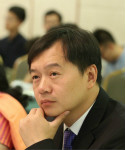| 个人简介 | |
|---|---|
 Prof. Mingxu Xia School of Materials Science Engineering, Shanghai Jiao Tong University, China |
|
| 标题: The formation of heterogenous interface in liquid aluminum alloys | |
| 摘要: Aluminum alloy has been extensively used in transportation vehicles and civilian engineering, where the heterogenous interfaces adjacent to the intermetallics or between the matrix and the inclusions dominate the application properties of the alloy. In this paper, we reported the formation of the heterogeneous interface during solidification. The liquid structure and its variation were recorded right next to the interface on the synchrotron radiation facility using high energy x-ray diffraction (HE-XRD) method. The atomic structure was also simulated based on the obtained pair distribution function (PDF) using Reverse Monte Carlo (RMC) method. The variation of the undercooling value suggested that the formation of the interface is related to the rearrangement of the atomic structure in the liquid and the accumulated strain at the interface can be observed through high resolution transmission electron microscopy. The interfacial energy of the stressed interface can be expressed by the several bi-crystal interfacial models. This finding extend our understanding on the formation of the interface at atomic scale and the relevant nucleation behavior on heterogenous interface. | |
| 简介: Dr. Mingxu Xia, Dean of Yinchuan Institute Materials of SJTU, China; Associate professor of School of Materials Science Engineering, Shanghai Jiao Tong University (SJTU); member of Solidification Science and Technology branch of CMRS. Before he joined in SJTU, he worked for Brunel University London, UK for 7 years as senior research fellow. His research mainly focuses on the atomic mechanism of solidification, the technology of casting process control and the solution for new technology applications. The major approaches used for his research are in situ synchrotron radiation analysis, X-ray analysis, high resolution TEM, et al. The research on casting technology focuses on the near-net-shape forming and unidirectional casting. Based on his research, the atomic mechanism of nucleation was proposed where the classical nucleation theory was revisited through experimental point of view and the new scenario of nucleation was developed further. New equipments for solidification were also invented for the fabrication of new materials. He published over 90 papers in top journals as ACTA Mater., Appl. Phys. Lett., Metall. Mater. Trans. A et al., cited by 1011 times, and wrote 2 chapters in books on metallic glasses. | |
